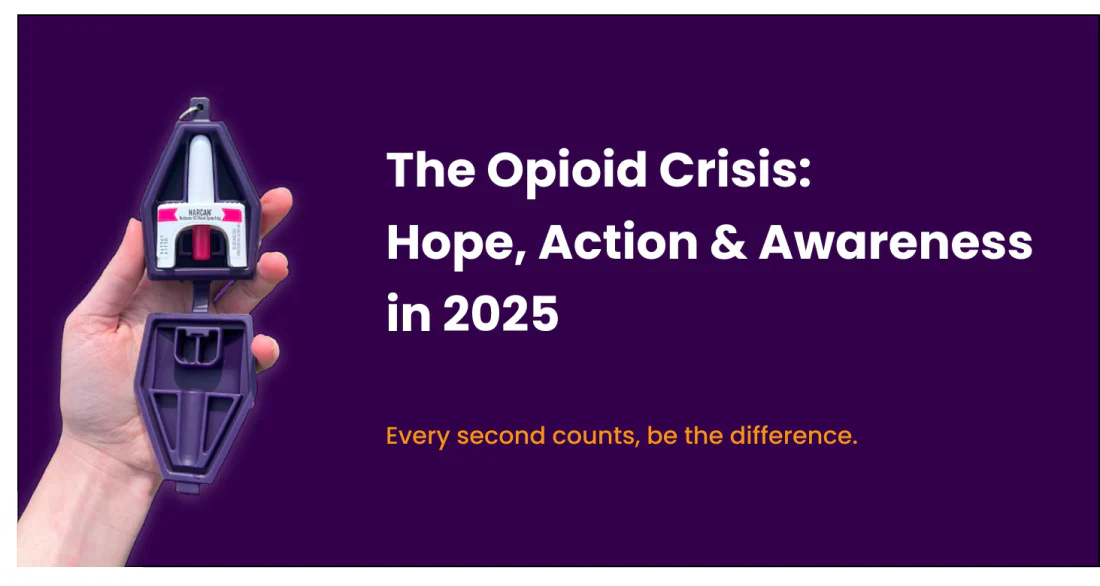
What’s Really Happening with the Opioid Crisis in the U.S. Right Now
Share
In 2025, for the first time in a while, overdose deaths have gone down. That means efforts like awareness, education, emergency response, and tools such as naloxone are starting to make a real difference. The crisis isn’t over, but we’re moving in the right direction.
In this blog, we’ll walk you through where things stand now, what’s improving, what still needs work, and how being prepared can truly help save lives.
Good News First: Fewer People Are Dying from Overdoses

According to the CDC (Centers for Disease Control and Prevention), overdose deaths have gone down by 24% in the last year. That’s a big deal. About 87,000 people died from overdosing on painkillers in 2024, which is still a lot, but it’s better than the 114,000 the year before. It’s a hopeful sign, and it means that awareness, action, and tools like naloxone are starting to work.
This drop shows us that efforts are finally starting to pay off. More people are aware of the dangers. Communities are getting more involved. First responders and even everyday citizens are carrying naloxone, a medication that can reverse an opioid overdose if given in time. Public health campaigns, expanded access to treatment, and harm reduction strategies are all beginning to make a meaningful impact.
It doesn’t mean the crisis is over. Far from it. But after years of watching the numbers climb higher and higher, this decrease is a moment of relief—and motivation to keep going. People are talking more openly about addiction. They're learning how to respond in an emergency. And life-saving tools are becoming more accessible.
So yes, this is still a serious issue. But for the first time in a long while, there’s a bit of light breaking through the darkness. And that gives us something important: hope.
What Are States Doing About It?
Let’s take a look at what a few U.S. states are doing to fight this crisis.
Texas
In Texas, deaths from drug overdoses went up by 75% in just five years. That’s scary. But now, Texas is working with the CDC to improve the situation. They created something called the TODA plan, which includes a website where you can easily buy naloxone (Narcan)—a medicine that can stop an overdose and save a life.
Oregon
Oregon changed its drug laws recently. Now, if someone is caught with small amounts of drugs, it’s considered a crime again. The idea was to get people into treatment instead of just punishing them. But some people say it’s leading to more arrests, especially in poorer communities. So, it’s a bit controversial.
California
California is cracking down hard on illegal drugs. In just the first two months of 2025, they took over 650,000 fentanyl pills off the streets. Fentanyl is super dangerous—even a tiny amount can be deadly. This move is helping keep a lot of it away from the public.
What’s Naloxone, and Why Does It Matter?
Let’s talk about one of the most powerful tools we have in the fight against the opioid crisis—naloxone. You might have heard of Narcan, which is the most well-known brand name for naloxone. There’s also a generic Narcan available now, making it more affordable for communities that need it most. It’s a life-saving medication that can quickly reverse the effects of an opioid overdose, buying precious time until medical help arrives.
Think of it as a second chance—a way to pull someone back from the edge when every second counts.
Thanks to growing awareness and public pressure, naloxone is now available over the counter without needing a prescription. That’s a huge step forward. It means everyday people—not just doctors or EMTs—can keep naloxone on hand and be ready to use it if the situation ever arises. Whether you’re a parent, a teacher, a friend, or just someone who wants to be prepared, having access to naloxone puts you in a position to save a life.
Not sure how naloxone is administered? It’s often available as an injectable pen but more commonly sold as Narcan, an easy-to-use nasal spray that anyone can learn to use in minutes.
But here’s the thing—having naloxone is only part of the solution. The other part is awareness. Unfortunately, a lot of people still don’t know what naloxone is, how to use it, or even that they can buy naloxone at a local pharmacy.
That’s where education comes in. Across the country, schools, community centers, and even workplaces are stepping up. They’re distributing Narcan kits, offering training sessions, and helping people learn how to respond calmly and confidently in an overdose situation.
Are There New Kinds of Painkillers That Aren’t Addictive?
One reason the opioid crisis started is that people were taking opioids for pain—and then getting addicted. Now, scientists are working on non-opioid painkillers that still help with pain but don’t cause addiction.
Some of these new medicines work differently in the brain, so people won’t get “high” from them. That’s promising, but they’re still being tested, so it might take a while before they’re widely available.
These alternatives might also reduce severe drug withdrawal symptoms that people face when trying to get clean.
What’s Helping Reduce Overdose Deaths?
Here are a few reasons why things might be improving:
More people have naloxone and know how to use it.
-
Some states are changing laws to focus more on helping people instead of just punishing them.
-
Public awareness is growing. People are talking more openly about addiction and how to get help.
- Access to rehabilitation centers is improving.
But There Are Still Challenges…
Even though deaths are down, we still have a long way to go:
- Fentanyl is still out there. It’s one of the most dangerous drugs, and it’s often mixed into other pills without people knowing.
- Not everyone has equal access to help. In some areas, it’s hard to get treatment or naloxone.
- Some laws still make it harder for people struggling with addiction to get the support they need.
- Severe withdrawal symptoms can also complicate recovery and increase health risks.
- Sometimes, people only notice addiction when signs like opioid pupils—very small, pinpoint pupils— appear, which can already be too late.
At Last: What Can You Do?
If you or someone you know is dealing with opioid use or addiction, know that help is out there. Here’s how you can make a difference:
-
Carry naloxone. It could save someone’s life.
-
Talk openly about addiction. The more we talk, the less shame people feel about getting help.
-
Learn more about what opioids are and how they affect the body.
- By the way, if you or someone you know wants to keep naloxone on hand but prefers something more discreet and portable, there are some great carrying solutions out there — like compact, everyday-use cases that can fit right into a bag or pocket. Products like these are making it easier for people to be prepared without drawing attention, which can really help in an emergency.


